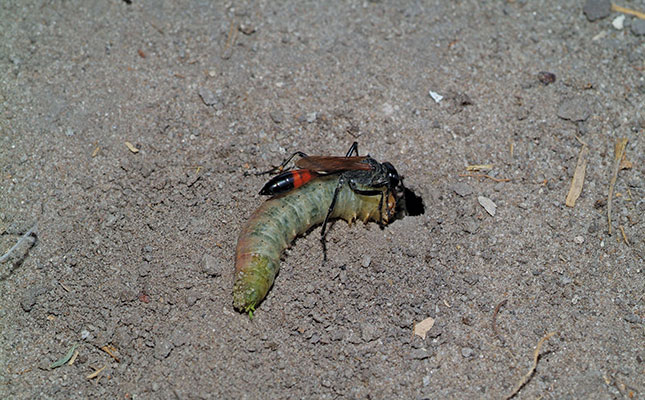
Scientific name: Spodoptera littoralis.
Family: Noctuidae
Distribution: Africa, Israel and Mediterranean Europe.
Description
This prodigious feeder is known to attack more than 40 plant species, including cabbages, cauliflower, spinach, potatoes, carrots, corn, wheat, maize, soya beans, sunflowers, and tomatoes.
It can be extremely destructive; an outbreak in Tanzania in 2006 is thought to have destroyed more than 500 000ha of cereal crops.
The larvae, which reach a length of up to 4,5cm, are greyish brown to dark green when newly hatched, but become more reddish brown with each successive instar (the stage in between moults).
A dark stripe bordered on either side by a thin yellow line runs along the back, while yellow lines and white spots are also present along the flanks. The caterpillars are found in large numbers on plants after the rainy season.
The larvae first feed on the tender underside of the leaf, leaving little more than the veins behind.
As they begin to mature, they gradually move to the upper surface of the leaf and then disperse throughout the entire plant, where they begin to attack the stem.
Not only does this harm the plant, but the caterpillars are vectors for the introduction of secondary infections by fungi and bacteria.
Reproduction
The adult moth, Spodoptera littoralis, has brown, reddish-brown, tan and grey geometric patterning and spots, a wingspan of 3cm to 4cm, and a 2cm long body.
The forewings have pale lines running along the veins and a distinctive A-type marking at each tip. The hindwings are fringed with hair and are creamy-white with brownish edges.
A female can lay between 1 000 and 2 000 eggs in batches of 100 to 300 on the underside of a leaf of the chosen host plant.
Each egg is 5mm long, yellowish-white in colour and covered with orange-brown hairs from the female’s abdomen. Depending on temperature and distribution, a typical life cycle will range from 19 to 140 days.
Control measures
The moth is nocturnal, migratory and capable of covering more than 1,5km in a night. Population numbers may fluctuate widely depending on distribution and temperature.
The larvae are climate-sensitive, with high mortality at temperatures below 13°C and above 40°C.
Caterpillars and eggs can be removed physically and destroyed, but great care must be taken in disposing of the eggs and caterpillars, as well as the plants they have been found on, to minimise further spread.
Insecticides containing methoxyfenozide can be an effective control measure, although insecticide resistance is well-documented among these caterpillars.
This is where botanical insecticides such as neem oil, pyrethrum and pongam can be effective, as many of these insecticides also contain mixtures of biologically-active regulators that inhibit the onset of pest resistance.
Insect growth regulators and slow-release pheromone formulations that disrupt the mating cycle have also been used successfully. But it was the discovery of a nucleopolyhedrovirus (SpexNPV), Spodoptera exempta, in 2009 that proved to be one of the most effective control measures.
Natural predators
A number of predatory insects prey on this caterpillar, including braconid wasps, tachinid flies, ichneumon wasps, Encyrtidae, spiders and birds.
Bats prey on the moths. It is doubtful whether integrated pest management alone is enough to cope with a serious outbreak, but with small numbers, it can certainly prove highly effective.
Please note: this series is only a guide to identifying pests. The control methods discussed are merely suggestions. For help with area- or crop-specific control, consult an agricultural extension officer.
Following outbreaks of army worm in the Mokopane area in Limpopo and Rayton in eastern Gauteng, the Limpopo Red Meat Producers’ Organisation (Limpro) has suggested:
Spraying with pyrethroid or cypermethrin;
Spraying in the morning when the worms are visible and moving;
Avoiding spraying at midday.
Paul Donovan, a biologist, has worked with reptiles and insects in zoological collections in the UK. He is based in Botswana, where he advises farmers on biological control agents.












